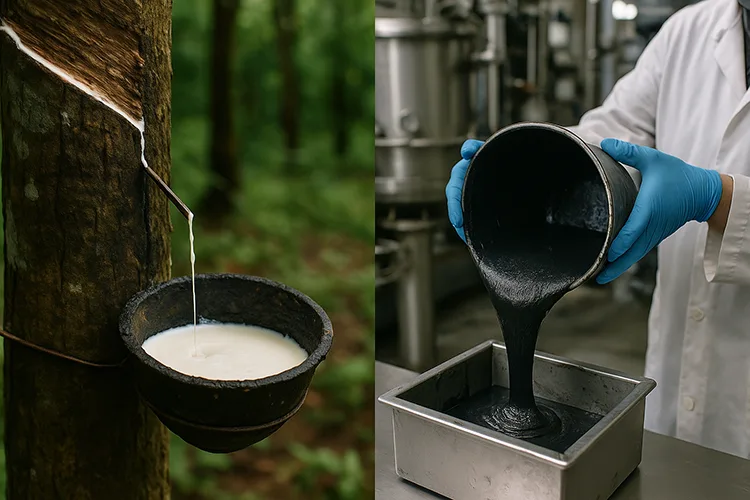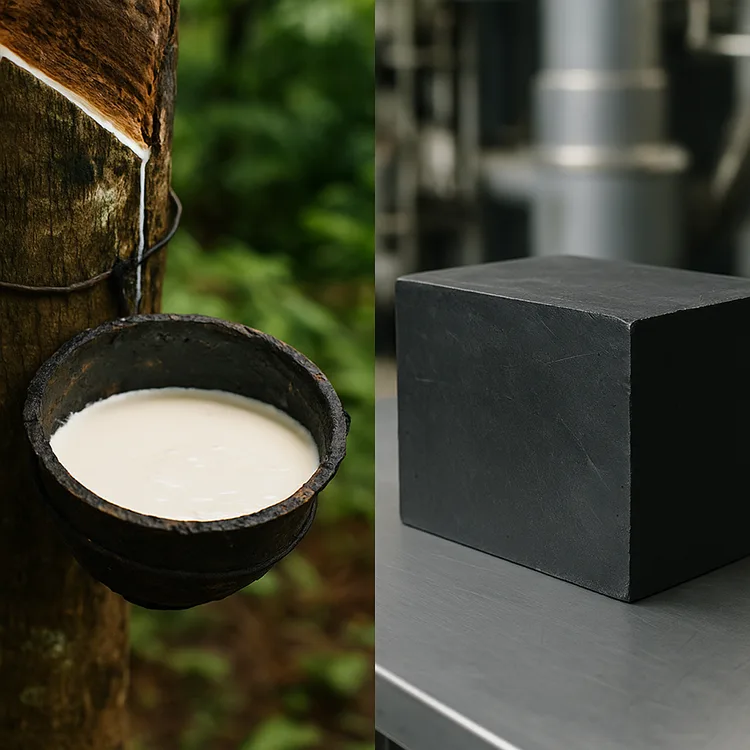I. Introduction
Which is better—natural rubber or synthetic rubber?
My Answer: Synthetic rubber performs better in environments involving chemicals, high temperatures, and outdoor exposure, while natural rubber stands out for elasticity, tensile strength, and superior vibration absorption. But the truth is, neither material is objectively better across the board. The real question should be: Which rubber is better for your specific application?
As someone deeply involved in rubber product manufacturing, I’ve seen what happens when the wrong choice is made. A seal that cracks under UV exposure, a hose that swells in contact with fuel, or a gasket that tears under repeated motion—all of these are real consequences of mismatched material selection. The wrong decision can lead to performance failures, costly recalls, and even compliance violations.
That’s why this article exists. I want to walk you through a clear, professional comparison of both rubber types—not just their properties, but also their environmental resistance, durability, real-world use cases, and cost considerations. I’ll even cover the questions buyers and designers frequently ask, and finish with a simple framework to help you choose the right rubber every time.
Let’s dive into the fundamentals first.
II. What Are Natural Rubber and Synthetic Rubber?
A. Natural Rubber (NR)
Natural rubber originates from the latex sap of the Hevea brasiliensis tree, commonly grown in Southeast Asia. The latex is harvested through a process called “tapping,” where incisions are made in the bark, allowing the white fluid to flow out and be collected. After coagulation and drying, the latex is processed into solid rubber sheets or blocks.
At the molecular level, natural rubber is composed mainly of cis-1,4-polyisoprene, a polymer known for its high elasticity. This unique structure gives NR outstanding tensile strength, flexibility, and tear resistance—qualities that make it ideal for high-stress, low-temperature, or shock-absorbing applications.
Historically, natural rubber was a catalyst for industrial development in the 19th and early 20th centuries. It played a critical role in the production of tires, belts, and gaskets during the rise of the automotive industry. Even today, NR remains unmatched in elasticity and rebound resilience, making it indispensable for certain industries despite the availability of modern alternatives.
B. Synthetic Rubber (SR)
In contrast, synthetic rubber is made from petroleum-based monomers through various polymerization processes. Unlike natural rubber, SR is not derived from biological sources but engineered in chemical plants. This allows for controlled performance characteristics—a key advantage in industrial design.
There are many types of synthetic rubber, each tailored for specific needs:
- SBR (Styrene-Butadiene Rubber) – commonly used in car tires and footwear.
- NBR (Nitrile Rubber) – excellent for oil and fuel resistance; often used in automotive and hydraulic seals.
- EPDM (Ethylene Propylene Diene Monomer) – highly resistant to UV, ozone, and water; ideal for outdoor and roofing applications.
- FKM (Fluoroelastomer, e.g., Viton®) – offers extreme chemical and heat resistance, used in aerospace and chemical processing.
- Silicone Rubber – flexible at a wide temperature range and highly inert; used in food, medical, and electronic industries.
This engineered diversity gives synthetic rubber an edge in application-specific performance and consistency. From kitchenware to aircraft fuel systems, synthetic rubbers are everywhere. Their formulation can be fine-tuned to balance cost, durability, resistance, and manufacturability.

III. Key Performance Comparison
A. Mechanical Properties
When it comes to mechanical strength, natural rubber is hard to beat. Thanks to its high molecular orientation, NR delivers exceptional elasticity and tensile strength, making it ideal for products that undergo frequent flexing, stretching, or compression—like shock absorbers, vibration mounts, or dynamic seals.
However, synthetic rubbers offer targeted mechanical benefits depending on their formulation. For example:
- SBR provides good abrasion resistance but lower elasticity than NR.
- EPDM offers excellent flex-fatigue resistance in outdoor environments.
- Silicone remains flexible across a wider temperature range than NR.
Still, for sheer elasticity and bounce-back, natural rubber maintains an edge—especially where consistent mechanical shock damping is required.
B. Resistance to Environment and Chemicals
This is where synthetic rubber outperforms in most cases.
Natural rubber is vulnerable to oils, fuels, ozone, UV, and extreme temperatures. Its organic structure breaks down more quickly when exposed to harsh environmental or chemical stress.
In contrast, synthetic rubbers can be designed to:
- Resist oil and fuel (NBR)
- Withstand extreme heat and chemicals (FKM)
- Endure weathering and ozone exposure (EPDM)
- Maintain performance across a wide temperature range (Silicone)
If your application involves exposure to oils, outdoor conditions, or heat, synthetic rubber is clearly the safer and longer-lasting option.
“Natural rubber may win the race in flexibility, but synthetic rubber owns the battlefield in hostile environments.”
C. Lifespan and Durability
Natural rubber ages relatively fast when exposed to oxygen, ozone, and sunlight. It tends to harden and crack over time, especially in unprotected outdoor conditions.
Synthetic rubber types, particularly EPDM and FKM, are far more durable. They resist environmental aging and retain flexibility and mechanical properties over longer lifespans, even when subjected to high thermal and chemical stress.
In terms of longevity, synthetic rubbers are usually the better investment—especially in applications that demand minimal maintenance or replacement.

IV. Application-Based Recommendations
A. Where Natural Rubber Excels
Natural rubber is still the preferred choice in many demanding mechanical applications, especially when high elasticity and vibration damping are crucial.
Here are a few areas where NR truly shines:
- Vehicle tires: Despite advances in synthetic blends, natural rubber still constitutes a major portion of truck and aircraft tires due to its superior grip and fatigue resistance.
- Shock absorbers and vibration mounts: NR’s rebound resilience makes it ideal for isolating vibration in industrial equipment and automotive systems.
- Conveyor belts and industrial rollers: The tensile strength and abrasion resistance of NR support high-load, repetitive-motion environments.
- Seals and gaskets in low-chemical, low-heat environments: Especially in indoor settings where chemical exposure is minimal, NR is a reliable and cost-effective solution.
In summary, if your application involves dynamic motion, impact absorption, and minimal exposure to chemicals or UV, natural rubber is not only sufficient—it may be the best choice.
B. Where Synthetic Rubber Dominates
Synthetic rubbers were developed precisely to overcome the limitations of natural rubber, and their performance in specialized conditions is unmatched.
Here’s where they dominate:
- Fuel systems and oil pipelines: NBR is the go-to material for fuel hoses, gaskets, and oil seals due to its excellent oil and solvent resistance.
- Outdoor sealing and roofing: EPDM offers outstanding weather, ozone, and UV resistance, making it perfect for gaskets, window seals, and roofing membranes.
- Medical and food-grade products: Silicone rubber is widely used in tubing, kitchenware, and baby products due to its biocompatibility and high thermal stability.
- Automotive and aerospace industries: FKM (like Viton®) performs under extreme heat and chemical conditions—ideal for engine seals and aircraft fuel systems.
- Electronics and insulation: Specialized SR compounds provide excellent dielectric strength, heat resistance, and dimensional stability.
In short, synthetic rubber is your best ally when your application environment is aggressive, temperature-sensitive, or regulation-driven.
V. Frequently Asked Questions
A. Is natural rubber biodegradable?
Yes, natural rubber is biodegradable. Because it’s derived from the latex of rubber trees, its molecular structure is organic and can break down naturally over time under the right conditions. This makes it a more environmentally friendly option in applications where end-of-life disposal or sustainability matters.
In contrast, synthetic rubbers are petrochemical-based and not biodegradable. They may persist in landfills for decades or require specialized disposal methods, especially in regulated industries like medical or aerospace.
B. Which rubber is cheaper or more stable in cost?
Synthetic rubber is generally more stable in cost because it’s produced from petroleum derivatives, which—while not immune to market swings—are less influenced by climate, disease, or geopolitics than rubber plantations.
Natural rubber prices can be volatile, affected by:
- Seasonal harvesting conditions
- Disease outbreaks in rubber trees
- Geopolitical shifts in producing countries (like Thailand, Indonesia, and Malaysia)
For high-volume or budget-sensitive applications, synthetic rubber often provides better cost predictability.
C. Is latex rubber allergenic?
Yes, natural latex contains proteins that can trigger allergic reactions, especially in sensitive individuals. These reactions can range from skin irritation to more serious respiratory symptoms.
To avoid this, industries such as healthcare and food processing often turn to synthetic rubber alternatives like nitrile or silicone, which are latex-free and pose no allergy risks.
D. Can synthetic rubber fully replace natural rubber?
Not entirely. While synthetic rubber can outperform natural rubber in many areas, it still falls short in elasticity, rebound, and tear strength under certain conditions.
For example:
- Aircraft and heavy-duty truck tires still use a large proportion of NR.
- Dynamic vibration-damping parts are often better served with NR.
So the answer is: synthetic rubber can replace natural rubber in many—but not all—applications. The choice always depends on your performance requirements.

VI. How to Choose the Right Rubber
A. Analyze Performance Needs
Before choosing between natural and synthetic rubber, start with a clear analysis of your working environment. Ask yourself:
- What is the operating temperature range?
- Will the part be exposed to oils, solvents, UV, or ozone?
- Is flexibility or compression set more important?
- Will the rubber experience constant motion, vibration, or pressure?
For instance, a gasket used in a heated, oily environment needs completely different properties than a static sealing strip in a cold, dry warehouse.
Define the functional expectations first—materials should be selected to meet them, not vice versa.
B. Cost vs. Performance Tradeoffs
Choosing rubber isn’t just about technical fit—it’s about balancing performance with budget.
- Natural rubber is often more affordable up front but may degrade faster in certain environments, leading to higher maintenance or replacement costs.
- Synthetic rubber can be pricier per unit but delivers longer life cycles and fewer failures in harsh conditions, making it more cost-effective over time.
Consider this: Is it worth paying less now but risking a breakdown later? Or should you invest more for reliability and longevity?
“Don’t just look at price per kilogram—look at performance per year.”
C. Real-World Scenarios
Let’s look at how this decision-making plays out in actual industries:
- Example 1: NR in Tire Manufacturing
Heavy-duty truck and aviation tires still rely heavily on natural rubber. Its high tensile strength and excellent fatigue resistance make it ideal for high-load, repetitive impact applications. - Example 2: NBR in Oil Pipelines
In industrial oil transfer lines, NBR seals and hoses are used for their superb resistance to petroleum-based fluids. Natural rubber would swell, degrade, and fail. - Example 3: Silicone in Kitchenware
Silicone’s temperature resilience, flexibility, and food-grade safety make it perfect for bakeware, baby products, and medical tubing—areas where NR or most SR types are simply unsuitable.
These examples show that rubber choice must be grounded in real application needs. A poor match doesn’t just compromise performance—it can compromise safety, efficiency, and profitability.
VII. Conclusion
So, which is better—natural rubber or synthetic rubber?
Here’s the final takeaway: Neither is universally better; each has strengths tied to specific use cases. Natural rubber is still unmatched in elasticity, mechanical resilience, and shock absorption. It’s the go-to for tires, dynamic mounts, and low-chemical environments. On the other hand, synthetic rubber offers tailored resistance to chemicals, temperature extremes, weathering, and UV—making it indispensable in sectors like automotive, aerospace, and healthcare.
The smartest choice is not about one material replacing the other—it’s about matching the rubber properties to your application.
If your environment involves fuel, oil, sunlight, or high heat, synthetic rubber is almost always the better fit. If your product needs superior rebound, wear resistance, or softness, natural rubber may give you the edge.
Still unsure? For mission-critical applications, I always recommend consulting with material specialists or testing samples under real-use conditions. That small investment in validation can save you massive costs down the road.
At Kinsoe, we help engineers, buyers, make the right rubber choices every day. Let’s talk if you need guidance on custom rubber components or want to request a sample tailored to your project needs.
References:

